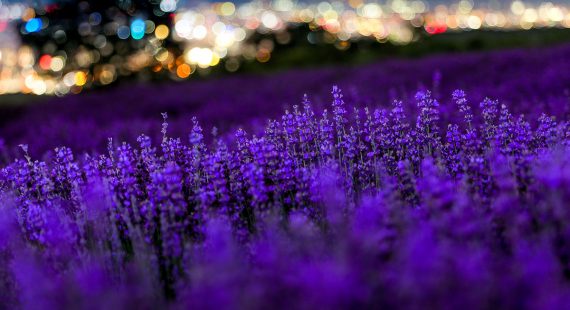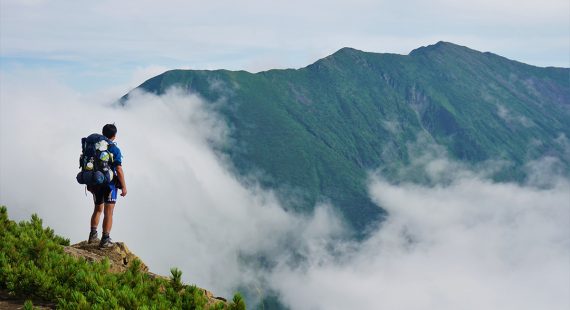(Written by Masaaki Tanaka)
WHAT IS HISTORY?
“History is a dialogue between the present and the past,” said E.H. Carr, a British historian and political scientist. Certainly, we who live in the present cannot look to the future without taking a proactive view of the past. In this sense, familiarizing yourself with World Heritage sites seems to be a casual way to do that.
As you may know, World Heritage Sites are natural, monumental works and archeological sites having outstanding universal value that are included on the World Heritage List in accordance with the World Heritage Convention adopted by the General Conference of UNESCO. They are protected under international cooperation and assistance as valuable and irreplaceable assets for all humanity. Traveling World Heritage sites not only deepens our understanding of the culture associated with them, but also leads to a better understanding of the diverse values that exist around the world and to mutual respect for each other. And as a result, we can build a peaceful world in the near future.
World Heritage sites are classified into three main categories. These are: cultural heritage, such as monuments, buildings and cultural landscapes created by human history; natural heritage, such as landforms and ecosystems that show the formation of the earth and the evolution of plants and animals; and mixed cultural and natural heritage, which combines the values of both. As of January 2023, there are 1157 World Heritage sites in the world, including 900 cultural, 218 natural, and 39 mixed cultural and natural heritage sites. Japan has 25 registered World Heritage sites, 20 cultural and 5 natural.
One of the key concepts concerning World Heritage sites is authenticity, which is used to emphasize the importance of maintaining and preserving heritage sites in the same condition in which they were built. This was based on Western thought, the culture of stone, and did not correspond to the Japanese culture of wood.
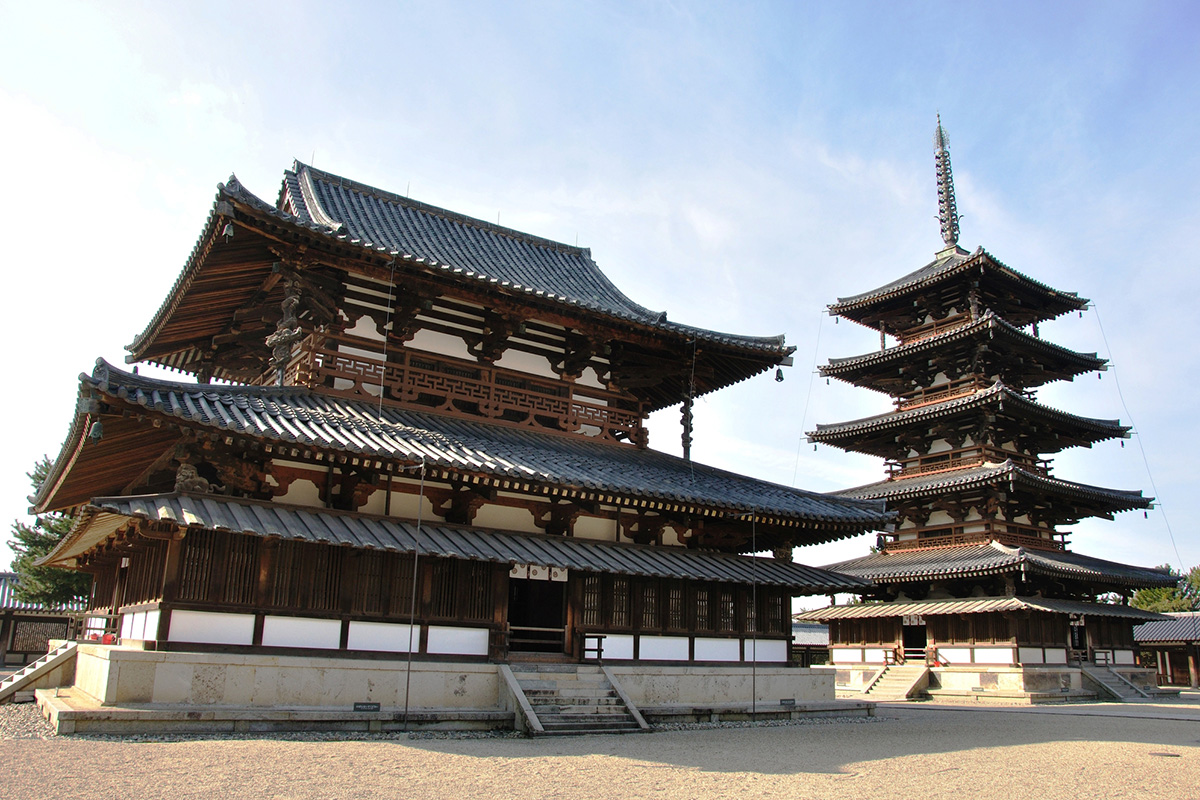
Japan felt the need to deepen the international community’s understanding of the preservation of wooden buildings and other structures, and appealed that authenticity can only be guaranteed by preservation techniques and restoration methods that have been practiced in Japan’s climate, culture, and history. As a result, the concept of authenticity became more flexible and was examined in accordance with each culture. As a result, Japan could register Buddhist Monuments in the Horyu-ji Temple Area, including the oldest existing wooden buildings in the world.
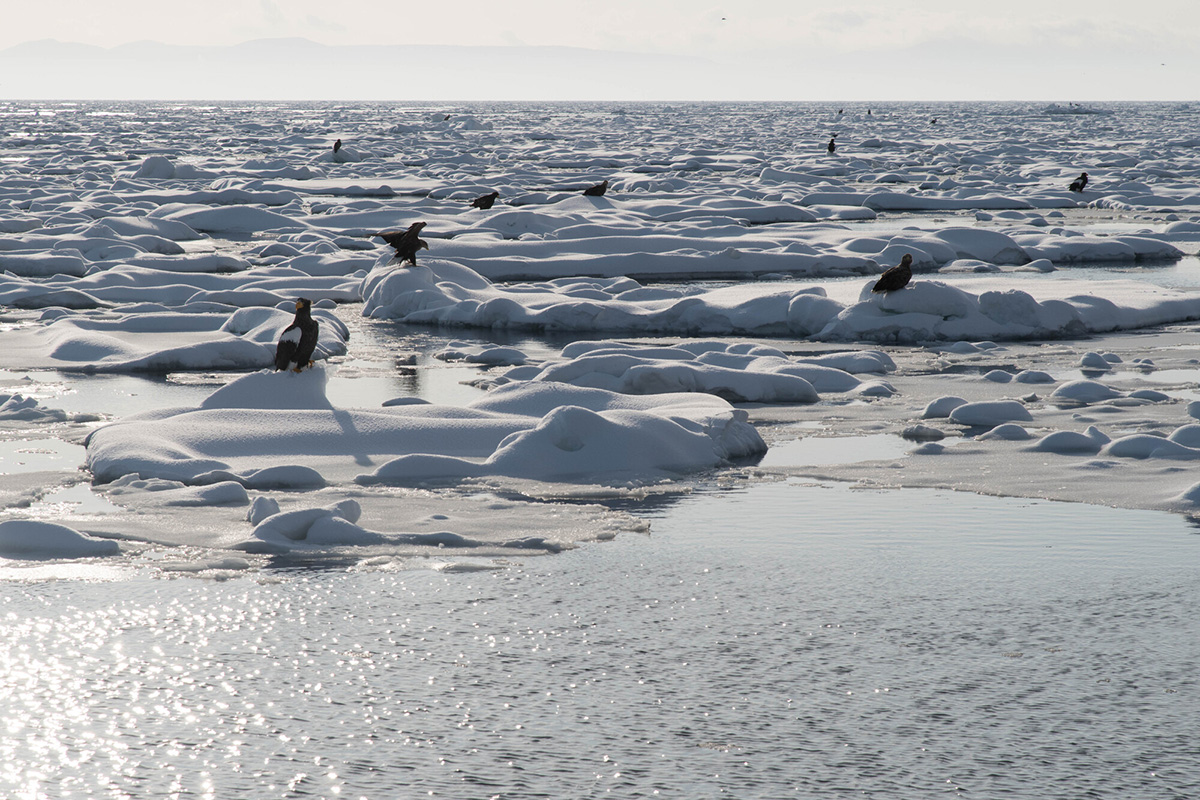
Hokkaido has two World Heritage sites: Shiretoko, a natural heritage one registered as Hokkaido’s first World Heritage site in 2005, and Jomon Prehistoric Sites in Northern Japan, a cultural heritage one registered in 2021. In Shiretoko, the food chain that begins with nutrients from the sea carried by drift ice provides a clear view of the ecosystem that connects the sea to the land. Shiretoko is also recognized as a habitat for rare and endangered species such as Blakiston’s fish owls and Shiretoko violets, etc., and is a World Heritage site that you should visit at least once another time, but this time we would like to introduce Jomon Prehistoric Sites in Northern Japan.
1. What was the Jomon period like? And what is the contemporary significance of the Jomon Period?
2. The Hakodate area, famous not only for the night view from Mt. Hakodate, but also for its history
3. The Date & Chitose area
4. The Toya area: spirit of mutual support and respect for life
5. A lot of other attractions in the Toya area, and coexistence with volcanoes
What was the Jomon period like? And what is the contemporary significance of the Jomon Period?
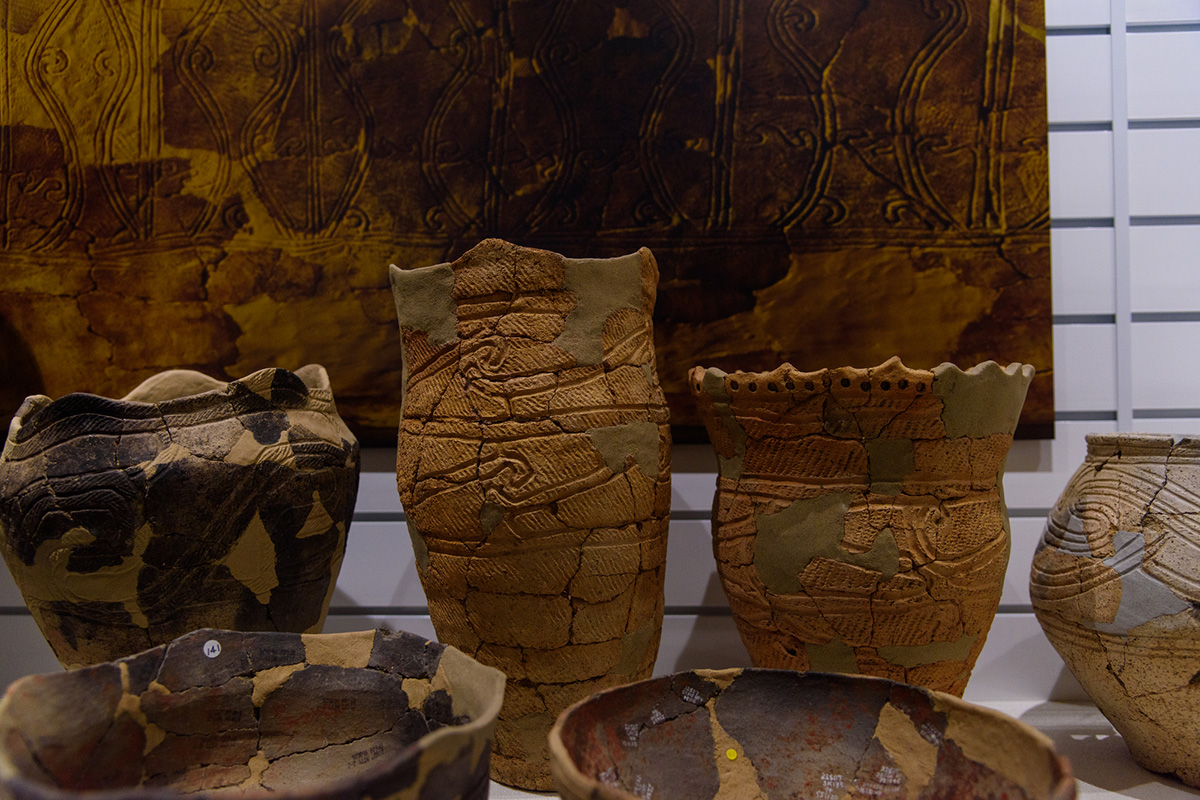
The Jomon Era is a period of culture with Jomon pottery, which began 12,000 to 13,000 years ago, following the Paleolithic period. The Jomon period is considered to be one of the rarest cultures in the world. It was a period of hunting, gathering, and fishing, and it was also a period of a settled way of life and the development of a sophisticated spiritual culture represented by clay figurines, which continued for more than 10,000 years. There are more than 90,000 Jomon sites throughout Japan, of which 17 sites in the four prefectures of Hokkaido, Aomori, Akita, and Iwate are registered as World Heritage sites. Of these, six are located in Hokkaido.
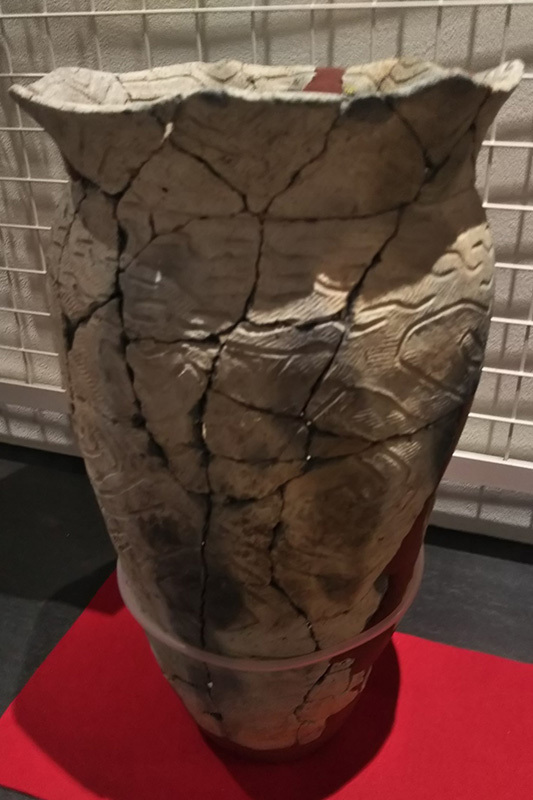
Why were 17 sites in Hokkaido and Northern Japan inscribed on the World Heritage List, despite the fact that Jomon sites are located all over Japan? First, the Southern Hokkaido region, such as the Hakodate and Toya areas, and the Northeast Honshumainland share the same burial methods, pottery patterns, clay figurines and tools, and form a huge cultural sphere compared to other regions, even though they are separated by the Tsugaru Strait. This is more extensive and stable than other cultural spheres, and is a remarkable example of the exchange of values there in prehistoric times.
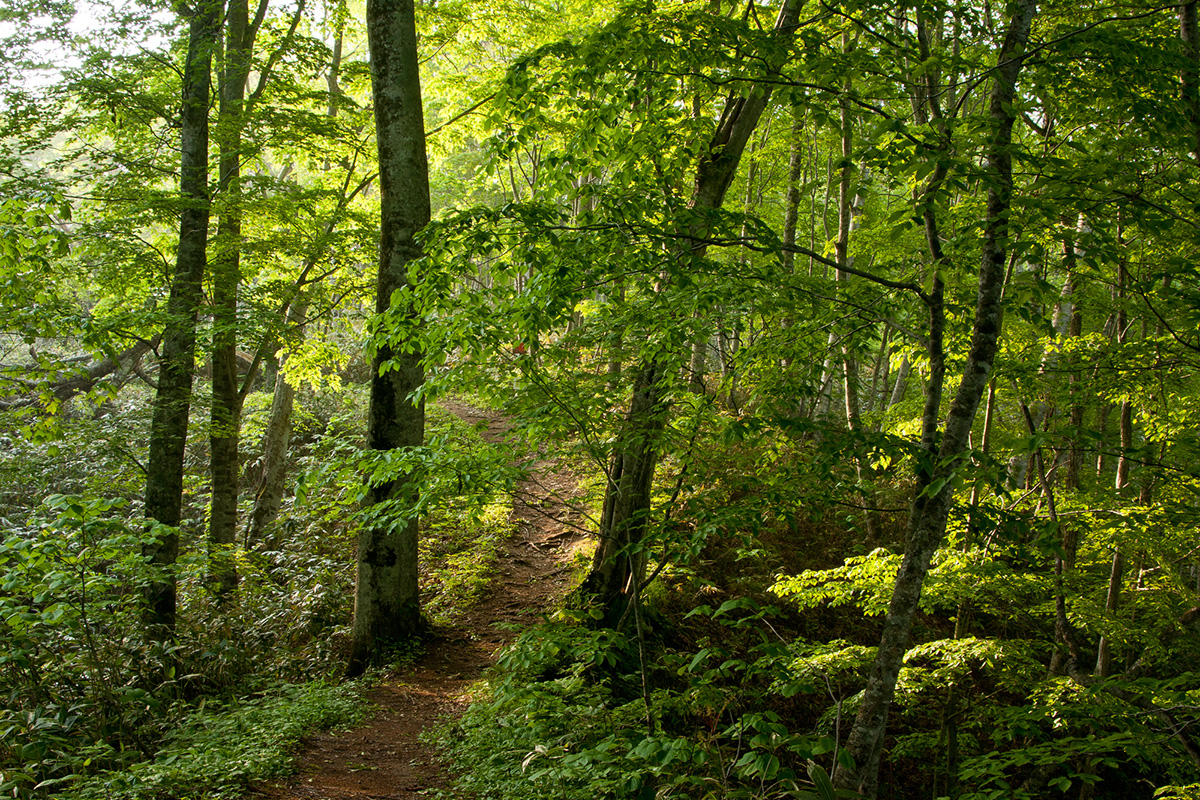
In addition, cool-temperate deciduous broad-leaved forests of beech and Japanese oak have spread to form forests with abundant natural blessings, and at sea, the intersection of warm and cold currents has fostered rich fishing grounds. Because of this favorable environment, the population grew and the settlements expanded. Jomon settlements developed and matured in terms of function and scale, including the establishment of places for rituals and cemeteries, and these 17 sites provide a clear picture of the transitions of these settlements.
Around 12,000 years ago, the Paleolithic Era came to an end as the Earth experienced rapid warming and the Ice Age came to an end. In Eurasia, the Paleolithic Era was followed by the Mesolithic Era, while in Japan, the Jomon Era dawned. In Hokkaido in particular, even after most of the Japanese archipelago shifted to the Yayoi culture, which was based on rice cultivation, the people did not base their culture on agriculture, but developed a unique history that continued through the Post-Jomon, Okhotsk, and Satsumon cultures to the Ainu culture. As a result, the spirit of respect for all living things, including a reverence for nature and the idea of symbiosis, remains strong in today’s Ainu culture.
People built settlements and lived in pit houses, and hunted, gathered, and fished for their livelihood. They also produced earthenware for cooking and food preservation, and clay figurines for ceremonial use. The “Jomon” in the name of the Jomon culture comes from the rope pattern on much of the earthenware of this period. The shapes and patterns on Jomon earthenware show outstanding artistry, and there is a lot of variation depending on the time period and region.
The Jomon people were able to live a so-called sustainable sedentary lifestyle for as long as 10,000 years by hunting, gathering, and fishing in a natural environment rich in biodiversity, which is rare globally, without agriculture or cattle farming that would have destroyed forests and rivers on a large scale. It is said that one of the reasons for this is that Hokkaido’s climate was too cold for rice cultivation, but it is also said that there was no need to cultivate rice because the food supply was already abundant, and hunting, fishing, and gathering techniques were further advanced thanks to the spread of iron tools. People lived in open villages with no fences, banks, or moats around them. They actively traded with each other over a wide area, and the absence of weapons, armor, or injured human remains suggests that there were no intergroup wars. These are things that should be of particular interest to us today.
As you know, the SDGs are Sustainable Development Goals for us. Simply put, they are plans and goals that everyone in the world should work together on to solve issues such as environmental problems, discrimination, poverty, and human rights problems around the world by 2030. The “sustainable” means that human activities can be sustained without adversely affecting the natural environment. When we compare the Jomon period with each of the SDG’s goals, we realize that the Jomon period was close to reaching the goals in many areas, and there are a lot of hints as to how we should live in the future. The Jomon culture’s spirit of living in harmony with nature contains universal value that is relevant not only today, but also for the future of society.
Now we will show you the following six sites located in Hokkaido.
1. Ofune Site in Hakodate
2. Kakinoshima Site in Hakodate
3. Kitakogane Site in Date
4. Kiusu Earthwork Burial Circles in Chitose
5. Irie Site in Toyako
6. Takasago Burial Site in Toyako
The Hakodate area, famous not only for the night view from Mt. Hakodate, but also for its history
1. Ofune Site in Hakodate

The Ofune Site is a large-scale settlement from the late Early to Middle Jomon periods, located on a coastal terrace facing the Pacific Ocean. So far, the remains of more than 100 pit buildings have been identified overlapping each other, indicating long-term settlement. In addition to the large-scale artificial mounds and residential areas, there were also ritual sites, storage areas, and burial spaces. Many chestnuts have been excavated from the Ofune site and were one of the main food sources. Furthermore, most of the pillar wood that was turned into charcoal was chestnut wood. Chestnuts did not originally grow wild in Hokkaido and are thought to have been brought from the Honshu mainland during the Jomon period.
2. Kakinoshima Site in Hakodate
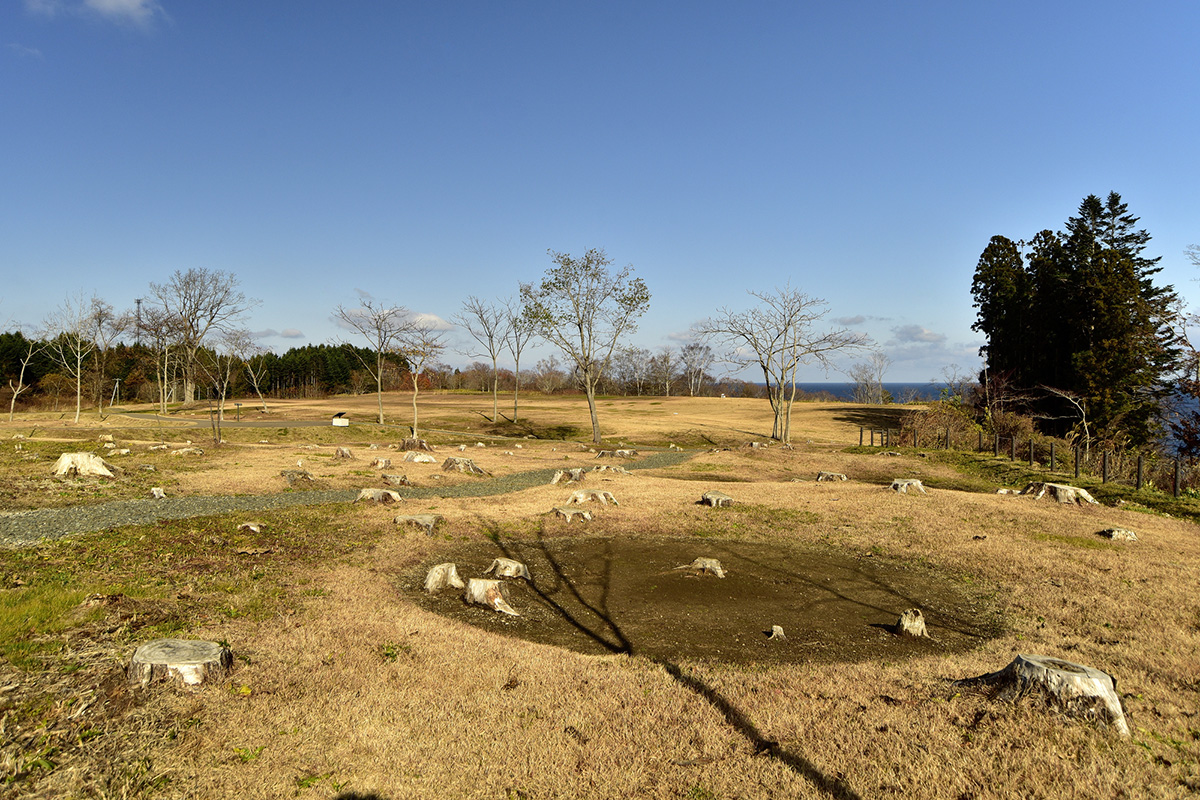
The Kakinoshima site is also located on a coastal terrace facing the Pacific Ocean, and is a settlement with remains and artifacts that show the spirituality there over a period of about 6,000 years from the first half of the Early Jomon Period to the second half of the Late Jomon Period. In early settlements, dwellings and cemeteries existed separately, which is valuable because it shows a precursor to the functional differentiation that occurred in later settlements. Later, living quarters consisting of pit buildings, a grave area consisting of tombs, and ritual places were formed, and sites where daily life and the sanctuary were separated can also be seen. The emergence of grave sites and ritual ones is believed to have strengthened the ties between the people living in the villages and led to the formation of ancestor worship. Clay tablets with an infant’s footprints pressed onto them have been excavated here. This is believed to be the footprint of a child who died at an early age. Here, too, we can sense the Jomon reverence and respect for life. There is also a related property, the Washinoki Stone Circle nearby, in the Hakodate area, where a ring-shaped row of stones and a pit tomb area were built, and it is thought to be a site where rituals and ceremonies were held.
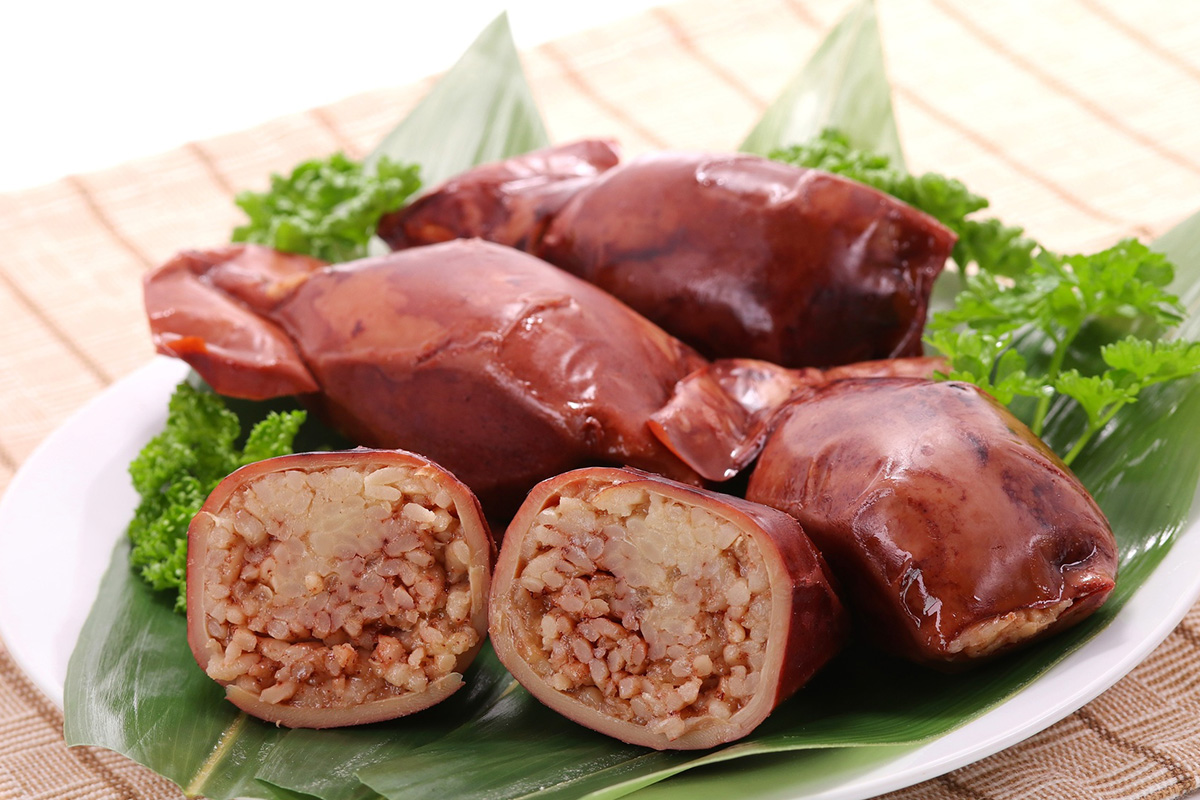
In addition, squid-shaped earthenware products have been found at the Washinoki Stone Circle here in the town of Mori, in the Hakodate area. ”IKAMESHI” is a dish made with squid and rice, which is still one of the Mori town specialties today. It is very interesting that squid-shaped earthenware was found only here. Incidentally, “IKAMESHI” is made by stuffing the body of a squid with glutinous rice and cooking it slowly. As the sweet and spicy soy sauce-flavored rice and squid are so delicious, please try one when you drop in there.
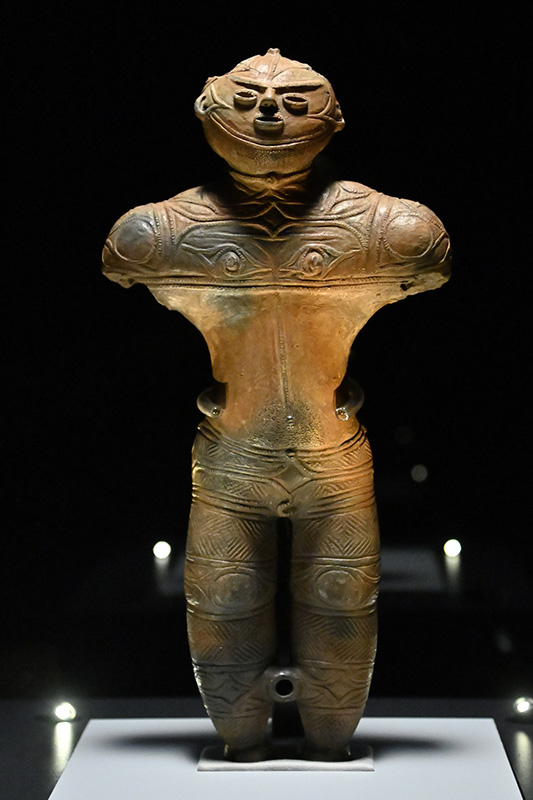
One of Hokkaido’s national treasures, a hollow clay figurine, was also excavated in the Hakodate area. It was found in a potato field located in Hakodate in 1975. It’s the largest hollow clay figurine in Japan. The workmanship is extremely elaborate and realistic, and the surface is well polished. The shape is well-proportioned, with a front-facing face, broad shoulders, a constricted body, and long legs. The basic design is a trident-shaped pattern expressed by pasting or carving out thin clay strings with incised patterns. The combination of the trigram and circular patterns is excellent and well represents the characteristics of the latter half of the Jomon period. The rope pattern on the legs, belly, and chin are painted in black, and the inside of the legs are painted in red pigment. There is a high possibility that the burial was associated with a group of clay pit tombs with stone arrangements, providing clues to the ritual and magical lifestyle and culture of the time.
The Date & Chitose area
3. Kitakogane Site in Date
The remains of a village mainly from the Early Jomon period have been discovered. These remains include five shell mounds, a water ritual site, pit building ruins, and grave sites. A large number of intentionally broken stone plates and grinding stones were found at the site of a lowland watering hole, suggesting that rituals and ceremonies associated with disposal were performed. The site has been developed and opened to the public as a historical park where visitors can experience Jomon culture, and an information center with exhibits of excavated artifacts is also located here.
4. Kiusu Earthwork Burial Circles in Chitose
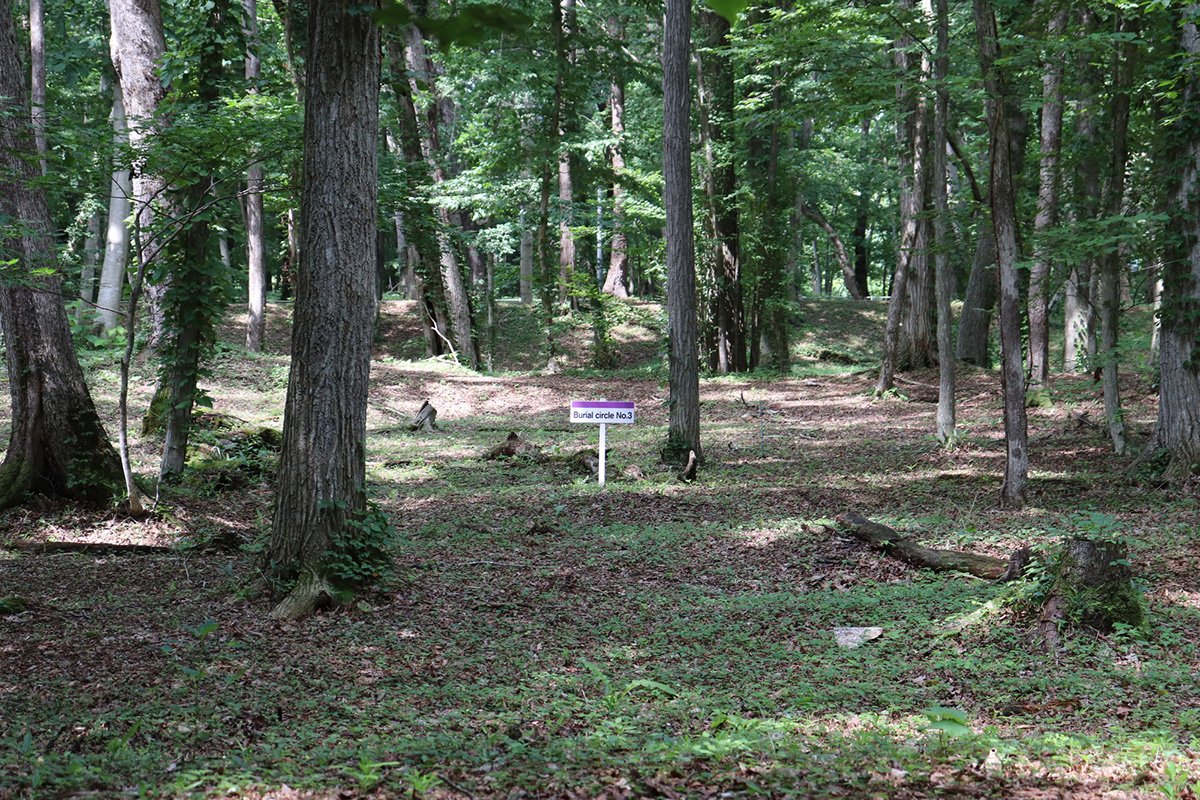
This is a group of extensive mass graves from the Late Jomon Period. Nine unique cemetery remains, in which multiple burial mounds are set in hollows inside a ring-shaped bank, are still extant.
The Toya area: spirit of mutual support and respect for life
Irie and Takasago shell mounds are located on a plateau 10-20 m above sea level between rivers. The ruins offer a panoramic view of Uchiura Bay (Eruption Bay) and Mt. Usu. Before visiting Irie and Takasago Shell Mounds, it is recommended to visit the Irie-Takasago Shell Mound Center, located halfway between the two sites, to learn some basic information. The exhibition room there displays various artifacts found in the Irie and Takasago shell mounds. In addition to earthenware and stone tools, tools made from animal bones and replicas of Jomon human bones are also on display.
5. Irie Site in Toyako
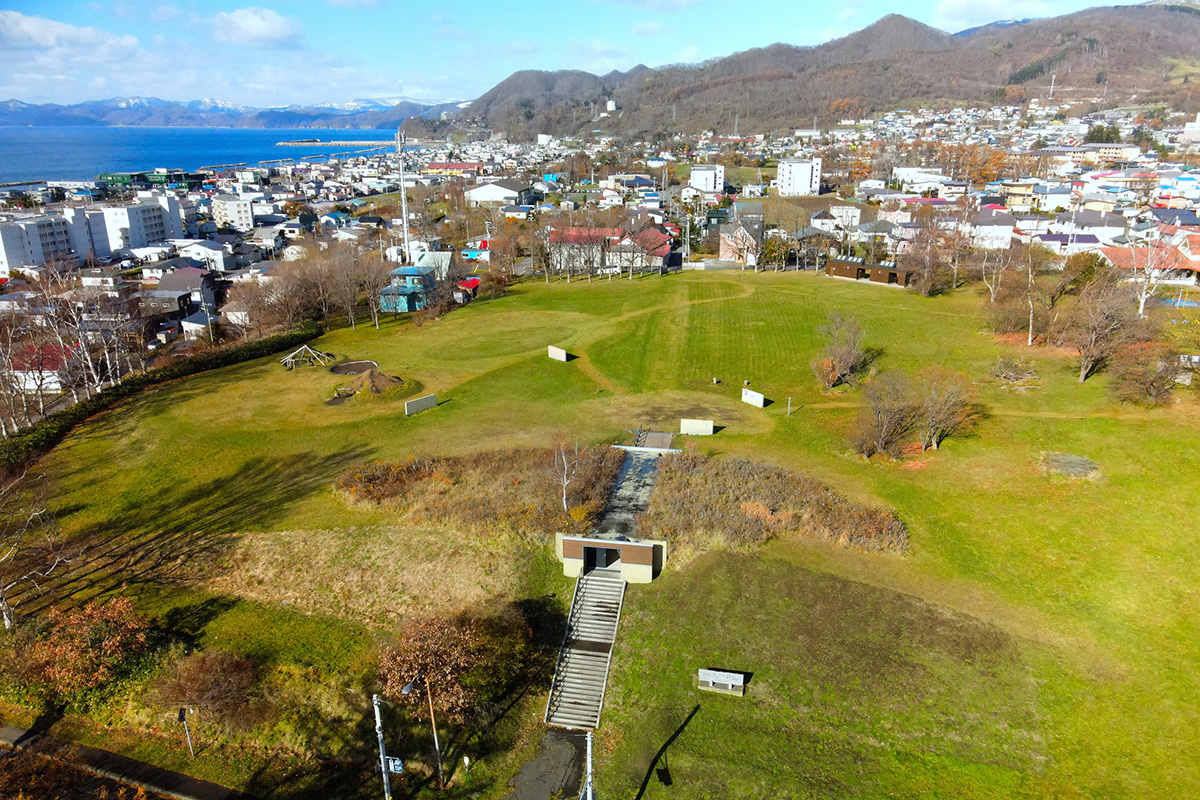
This is the site of a settlement with shell mounds built in the Early to Late Period. A number of pit building ruins have also been found here. The shell mound is 3 meters thick, and many earthenware items, as well as stone tools for hunting and bone and horn implements for fishing, have been found in the shell layer. Here you can also see a “stripped” cross section of a shell mound. That is a specimen taken from an actual shell mound and hardened with a glue-like substance. Here, you can see far less shells than other shell mounds and many bones of fish and dolphins, which are characterized by their dark color, as well as tools such as earthenware and stoneware items. In addition, a total of 15 human bones were found in graves discovered here, indicating that the shell mound was used as a burial site. One of them has the same head and trunk bones as a normal adult, but the bones of his arms and legs are abnormally thin, indicating that he was unable to move his limb muscles for a long time and needed constant care from childhood. Possible causes include polio or muscular dystrophy. In this sense, even those with disabilities that interfered with their daily lives spent at least a dozen years in the area, indicating that they were well cared for by people around them and bringing to light the Jomon people’s way of living by helping each other.
6. Takasago Burial Site in Toyako

Takasago Shell Mound is an archeological site where traces of daily life remain, mainly shell mounds from the very late Jomon period. Here, a mother and her baby were buried in one grave. It is believed that the mother died before giving birth to the baby. The death of an expectant mother is a very sad event, and the fact that her head was turned almost due south and that she was sprinkled with a lot of red pigment suggests that she was treated differently from a normal burial.
A lot of other attractions in the Toya area, and coexistence with volcanoes
The Toya area has not only World Heritage sites, but also has many other things to offer. Lake Toya and the lakeside hot spring/onsen resorts are among the most popular and well-known tourist sites in Hokkaido.

Fireworks can be viewed there every day from the end of April to the end of October. They are launched from a moving boat, and some hotels offer the opportunity to view them from their guest rooms as well as from the lakeside.

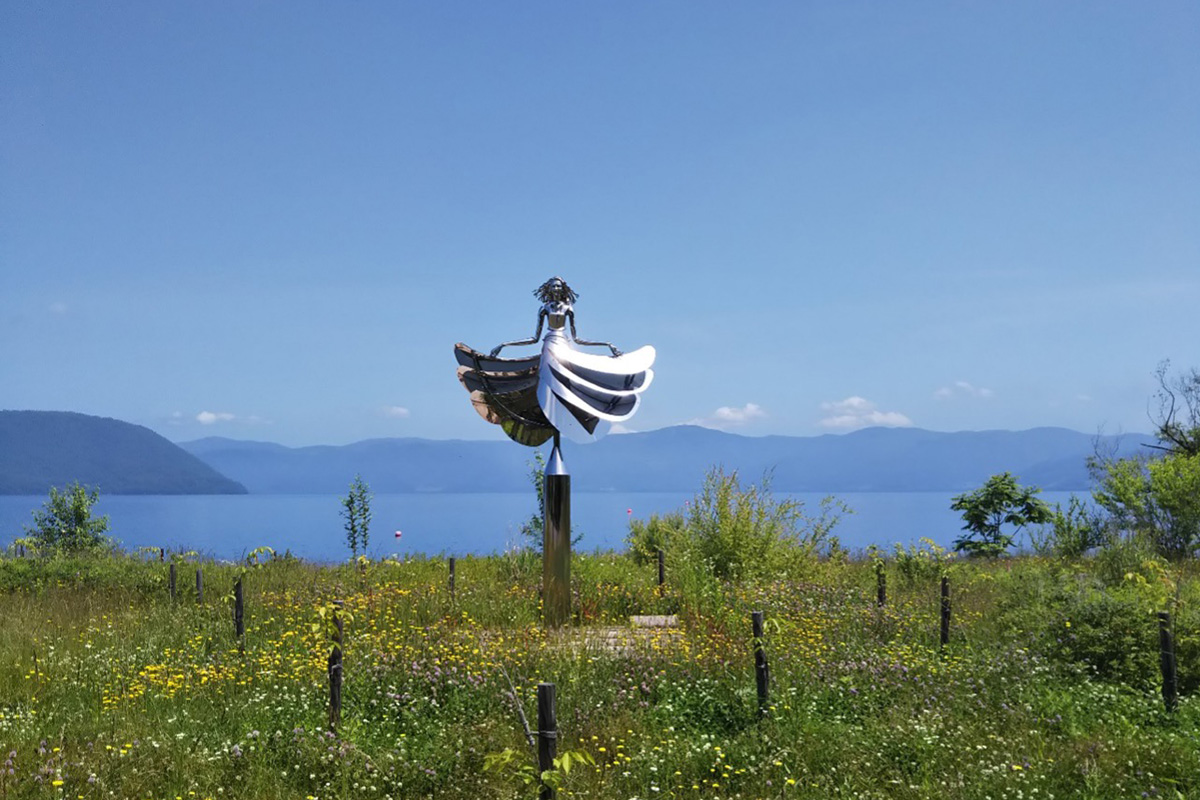
There are also 58 sculptures along the shores of Lake Toya, most of them scattered along the southern shore from Lake Toya Onsen to Sobetsu Onsen and the Toya area on the other side of the lake, making it an ideal driving course.
Lake Toya and the Mt. Usu area to the south of Lake Toya are registered as the Lake Toya-Usu Geopark as well. Lake Toya is a caldera lake formed by water in a depression created after a huge eruption that occurred 110,000 years ago.
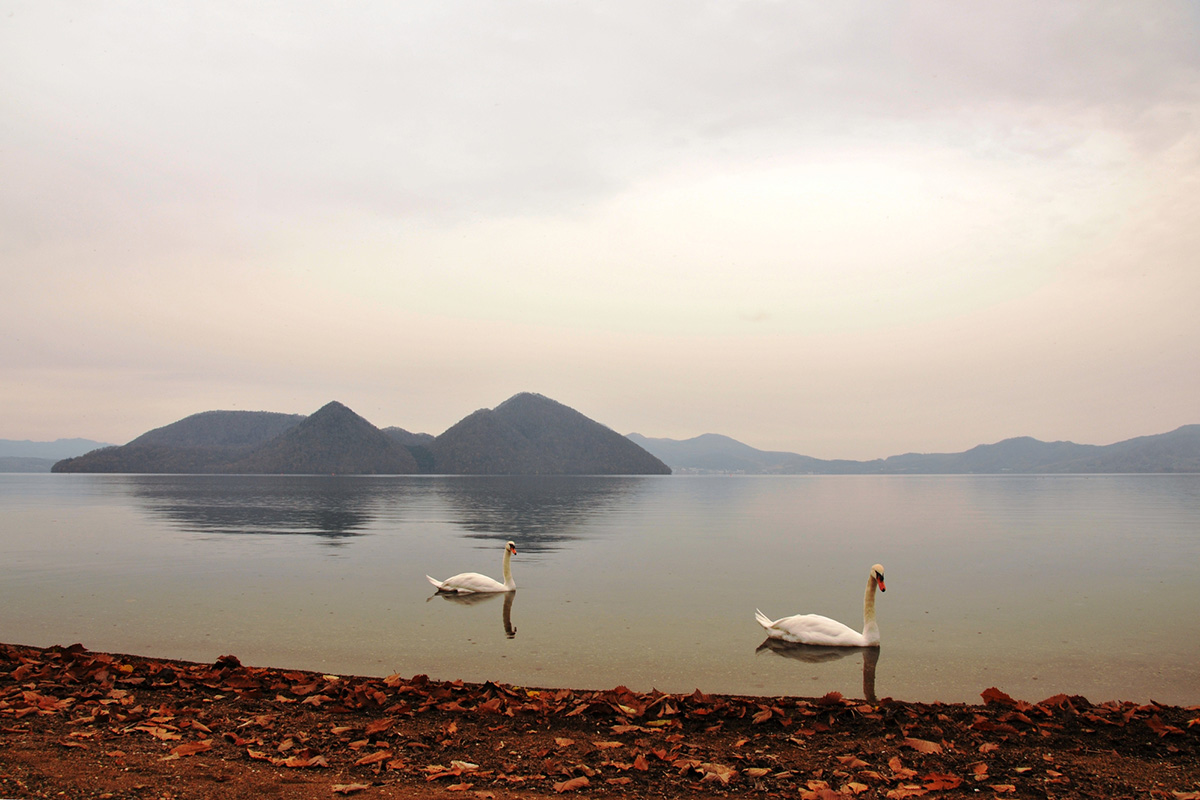
In the center of Lake Toya is a group of uninhabited islands collectively known as Nakajima. These islands are also lava domes formed by repeated eruptions that occurred 50,000 years ago. The largest island there, O-shima, measures 9.6 kilometers in circumference.

From spring to fall, visitors can disembark at O-shima and walk around the island while listening to the chirping of birds such as various kinds of tits, flycatchers, thrushes, warblers and turtledoves etc. and if you are lucky, you may see a family of Ural owls as well.
Mt. Usu is a volcano that is active right now, and you can feel the power of the volcano from the rising fumaroles, bare rocks, and wild eruption sites. Also located near Mt. Usu is Mt. Showashinzan. This is a miraculous volcano that grew in a little more than two years after the fields were uplifted by the 1943-1945 eruption of Mt. Usu.

It takes 6 minutes by ropeway from the foot of Mt. Usu to the summit station. The observatory at the summit station has an outdoor café and sofas, where you can enjoy a panoramic view of Lake Toya and Mt. Showashinzan. The crater and Uchiura Bay can be viewed from the crater field observatory, which is a 9-minute walk from the summit station.

Furthermore, a 45-minute walk along the Southern Rim Mountain Trail takes you to anotherobservatory, where you can get a close-up view of the rugged appearance of the crater that erupted in 1977. It is really fun to take a short trip there. Enjoy the scenery created by the volcano, eat delicious food created from its bounty, soak in the hot springs, and contemplate the very earth we live on. That is how to enjoy this region. However, we must not forget that coexistence with volcanoes is also an issue that must always be kept in mind, from ancient times to the present.
We, Hokkaido Treasure Island Travel, can propose various kind of tours to you as real experts on Hokkaido. We can offer you some attractive experiences during your trip according to your requests.
Some say it is an auspicious day when you’ve just thought of traveling to Hokkaido. So please feel free to contact us with any questions or requests anytime you are ready. Then your expectations for your trip will come true.
The first step in enjoying the Jomon sites is to visit them. And try to look around from the same viewpoint as the people of that time. Located near the sea, rivers, etc., you can better understand why they lived in those places. You can also feel the worldview of people who lived together with nature. Furthermore, many excavated artifacts show their wisdom, ingenuity in daily life, rich spirituality and artistry. Now is the time to visit Jomon sites there and think about the lives of people in ancient times while also drawing inspiration from them.
